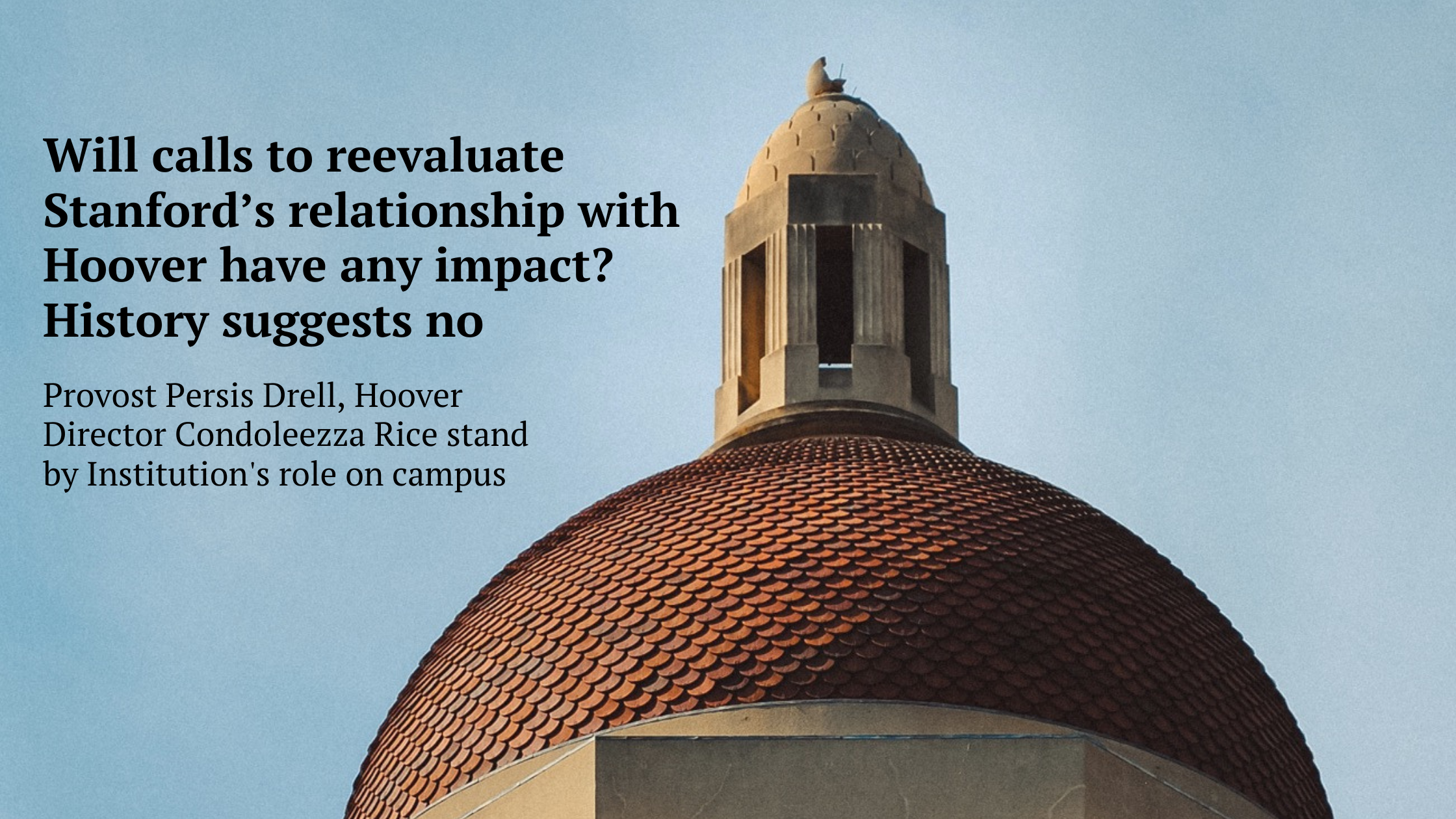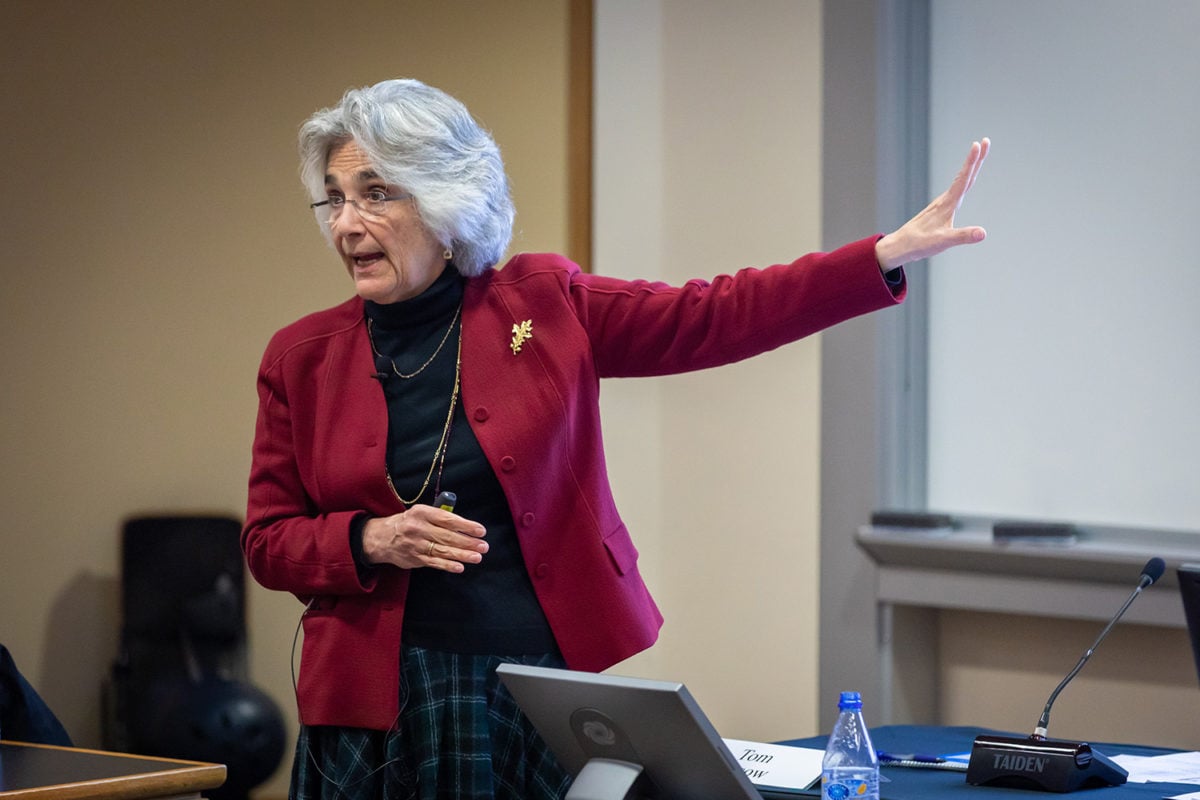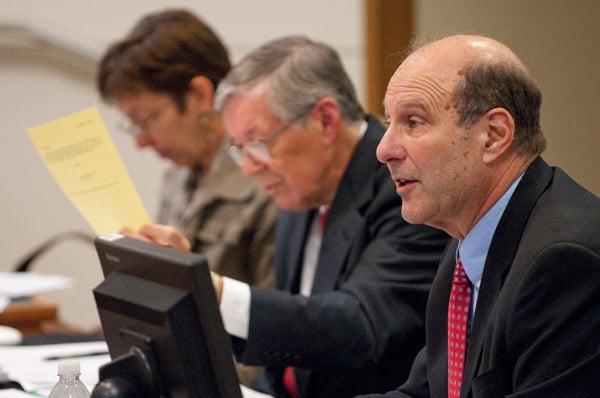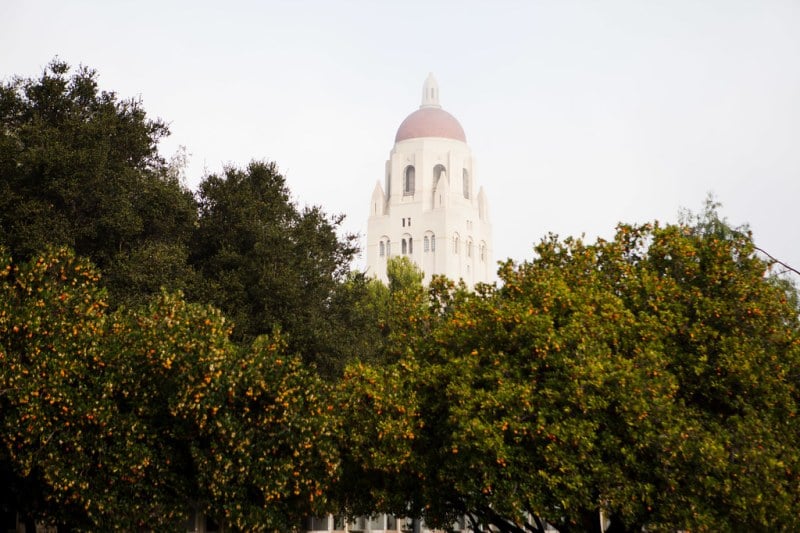
By Cameron Ehsan on November 9, 2020
In late February, when the coronavirus had just begun to infiltrate the United States, Hoover Institution board members were reportedly given a grave yet subtle warning about the dire impacts the COVID-19 epidemic, soon to be pandemic, would have on the economy and society at large. These notices came from the highest levels of government and President Donald Trump’s senior advisers, the very individuals who had been publicly downplaying the risk of the coronavirus and claiming that it had been defeated.
A memo documenting the meeting of Hoover board members and senior administration officials began to circulate, and within a day the memo reached four investment firms, guiding trading for elite investors, according to The New York Times. By the time trading closed on Feb. 26, the day after the Hoover Institution retreat in Washington, D.C., had ended, U.S. stock markets had fallen nearly 300 points from the previous week’s high. Hoover board members, many of whom are affluent Republican party donors, had access to insight gained directly from the president’s aides that was used to prioritize economic gain.
The warning has intensified calls to reevaluate the relationship between Stanford and the Hoover Institution — so far to no avail. No one outside the Hoover Institution knew about the early warning, according to Stanford spokespeople, but since it became public through The Times, Stanford leadership has not spoken out. After a professor asked at an October Faculty Senate meeting whether the University would take action in response to these reports, Provost Persis Drell said about Hoover, “In a very real sense, and I think this is important to keep in mind, they are, in fact, us.”
Disagreements on the Hoover-Stanford relationship date back to the origin of the Hoover Institution on War, Revolution and Peace. Founder and former President Herbert Hoover declared in 1959 the institution’s mission to Stanford’s board of trustees, as documented by former Stanford president Richard Lyman: “The purpose of this institution must be, by its research and publications to demonstrate the evils of the doctrines of Karl Marx — whether communism, socialism, economic materialism or atheism — thus to protect the American way of life from such ideologies, their conspiracies, and to reaffirm the validity of the American system.”
61 years later, the institution’s perceived ideological bias and lack of diversity have been points of criticism among Stanford faculty members and students. Repeated calls for Stanford to reevaluate its relationship with the Hoover Institution have been shut down by administrators who underscore the importance of academic freedom.
Russell Berman, a professor of comparative literature and German studies and Hoover senior fellow, told The Daily that calls to look into Stanford and the institution’s relationship are not fair and would narrow the range of perspectives on campus, which he believes would be a disadvantage to the community.
The liberty and flexibility afforded to the Hoover Institution, which largely operates independently within the larger structure of the University, has allowed the think tank to sponsor renowned researchers and maintain collections of valuable historical artifacts, while also spurring campuswide and nationwide controversies.
But Hoover scrutiny has risen to a new level during the COVID-19 pandemic, with medical faculty warning of falsehoods and misinformation peddled directly to the president of the United States by Hoover fellows, and other faculty explicitly distinguishing themselves from Hoover fellows.
Despite the division, University leadership is optimistic that by integrating Hoover with Stanford, they can normalize historically tense relations. “While in the distant past Hoover was more set apart from the rest of Stanford, in the last decade it has become much more integrated into the university,” Drell told The Daily in a statement.
Drell and others expressed hope that Hoover Institution Director Condoleezza Rice, a former Stanford provost and U.S. secretary of state who was appointed earlier this year, can improve the tense relationship, noting that Rice’s experience can best facilitate the institution’s ongoing integration with the University.
“I am committed to continuing to strengthen the important relationship between Hoover and Stanford,” Rice wrote in a statement to The Daily, crediting the centrally located Traitel building, which opened in 2017, as “a prolific bridge to the greater Stanford community, including the student body.”
Claims of conservative bias
Although the Hoover Institution was founded in 1919, it was initially established as a library dedicated to preserving historical documents of the First World War. In the late 1950s Hoover began to transform into a policy institution with residence fellows studying international affairs and later domestic policy. Controversy surrounding the institution first sparked when Herbert Hoover spoke to Stanford’s board of trustees in 1959 outlining the goals of his policy institute.
Hoover defined the purpose of the institution as opposing the “evils” of communism, socialism, economic materialism and atheism through research and publication. “The Institution is not, and must not be, a mere library,” Hoover proclaimed, adding that it will “constantly and dynamically point the road to peace, to personal freedom, and to the safeguards of the American system.”
Hoover’s statement concerned a number of Stanford faculty members. Assistant sociology professor William McCord told The Daily in 1969 that the institution’s mission statement is “inconsistent with the purposes of Stanford as a great university,” calling for University policy groups to focus on “finding truth” rather than “‘demonstrating the evils’ of disapproved beliefs.”
Other faculty members argued that Hoover fellows were using its affiliation with Stanford to advance an anti-communist agenda. An anonymous faculty member quipped in 1960 that the “Winds of Freedom don’t blow over there.”
Although Hoover’s words were uttered decades ago, they still ring true today for the institution. In 2019, then-Hoover Director Thomas Gilligan reaffirmed Hoover’s words in a statement to Stanford Politics: “Herbert Hoover’s 1959 statement to the Board of Trustees of Stanford University on the purpose and scope of the Hoover Institution continues to guide and define our mission.”
Hostility between the institution and its critics reached a breaking point in the 1970s. The institution’s office windows were boarded with plywood to prevent student protestors from shattering them with rocks. In 1972, for the first time in its history, Stanford dismissed a tenured faculty member, English professor Bruce Franklin, for disrupting a Hoover event featuring the former ambassador to Vietnam and inciting an unrelated riot.
“A myopic view of ideas can be a dangerous thing, and I am proud to be at a university whose mission is not threatened but strengthened by ‘preparing students to think broadly, deeply and critically.’”
CONDOLEEZZA RICE, HOOVER INSTITUTION DIRECTOR AND U.S. SECRETARY OF STATE
Despite assertions of neutrality by the institution’s leaders, Hoover fellows’ views were perceived to lean conservative. An anonymous former Hoover visiting fellow told The Daily in 1979 that “The Hoover Institution is an amalgam of free-market economists in the domestic situation and cold warriors on the international side.”
Stanford faculty members and students calling for inquiries into the Stanford-Hoover relationship have released numerous petitions and statements over the years, with little impact.
In the 1980s, more than 1,500 people, including over 70 faculty members, called for such an inquiry in a petition that read, “the existence of a partisan research and policy organization, whether liberal or conservative, within the University raises serious questions concerning the academic independence, integrity and reputation of the University.”
Hoover fellows pushed back on claims that the institution was not ideologically diverse in a 1997 Daily report. “One of our scholars took a poll a couple of years ago, identifying who is a Republican and who is a Democrat at Hoover and the result was that it was 50/50,” former Hoover Deputy Director Charles Palm said at the time.
The Faculty Senate more recently took up the issue of Hoover Institution’s role on campus in a meeting last year, when members took aim at the institution’s perceived conservative slant and lack of diversity.
“Why do we have an institution with an ideology idée fixe built into it on campus?” the late philosophy professor Kenneth Taylor asked. “To have that as part of the institution’s foundational character seems intellectually bankrupt.”
Gilligan defended the institution, saying that when he first arrived at Hoover, he was struck by the disagreement fellows had in policy areas. “I think there’s a bit more of a sense of diversity than what you think,” he added at the meeting.
In September, over 100 faculty members signed an open letter calling for the Faculty Senate to reconsider the institution’s relationship with Stanford. While there has been increasing debate about the Hoover Institution at Faculty Senate meetings, such discussion has failed to yield substantial change.
Comparative literature professor David Palumbo-Liu, who led the effort to release the open letter, told The Daily that there is a “contradiction” between the missions of Stanford and the Hoover Institution. Palumbo-Liu points to Hoover’s mission statement, which reads, “Ours is a system where the Federal Government should undertake no governmental, social or economic action, except where local government, or the people, cannot undertake it for themselves.”
“While I firmly believe that they have every right to promote” their belief, “Hoover produces knowledge, lectures, policy-papers, that re-enforce that message” without “creating anything that promotes the opposite point of view,” Palumbo-Liu wrote.
Palumbo-Liu wrote that he believes “Universities are supposed to be open-minded, objective, and open to find anything discoverable under standard research methods, and disseminate that information for the broad public good, not just for people who want to believe a certain point of view to the exclusion of other possibilities.”

L.A. CICERO/ Stanford News
Palumbo-Liu and other faculty members’ stance on Hoover contrasts with that of Stanford’s senior leadership. Drell, who has expressed support for the institution, wrote in a statement to The Daily that “members of our community hold many different views, and they are able to express those views. Other members of our community are able to challenge those views.”
“That is an important part of life in an academic community, and we have seen members of our community do exactly that,” Drell wrote.
Stanford’s Statement on Academic Freedom, adopted by the Faculty Senate in 1974, states, “Expression of the widest range of viewpoints should be encouraged, free from institution orthodoxy and from internal or external coercion.”
Rice told The Daily that the partnership between Hoover and Stanford makes both institutions stronger, writing “a myopic view of ideas can be a dangerous thing, and I am proud to be at a university whose mission is not threatened but strengthened by ‘preparing students to think broadly, deeply and critically.’”
“The Hoover Institution is a unique and indispensable resource that provides diversity of thought on campus in support of the university’s commitment to inquiry and discovery,” Rice added.
A special relationship
In 1959, Stanford’s board of trustees recognized the Hoover Institution as “an independent institution within the frame of Stanford University.” The delicate language used to describe the Stanford-Hoover relationship has been a source of confusion and disagreement over the extent of the University’s oversight of the institution.
The special relationship allows Hoover’s director to bypass the Academic Council and the provost entirely on many issues, reporting directly to Stanford’s president and board of trustees. Hoover does not follow the typical procedures related to appointments, promotion and budgeting required of academic departments and programs.
When former Hoover Director John Raisian named Donald Rumsfeld — a former secretary of defense who played a central role in the invasion of Afghanistan and the Iraq War — as a distinguished visiting fellow in 2007, it sparked campus outrage. Around 4,000 faculty, students and alumni signed a petition objecting to the appointment, saying it was “fundamentally incompatible with the ethical values of truthfulness, tolerance, disinterested enquiry, respect for national and international laws, and care for the opinions, property and lives of others to which Stanford is inalienably committed.”
Discussing the appointment to the Faculty Senate, Raisian said that although he did not regret the selection, he felt apologetic about not informing Provost John Etchemendy and President John Hennessy in advance. Although the Faculty Senate lacks jurisdiction over the Hoover Institution, it serves as an influential voice for faculty on many matters related to the University’s teaching and research mission.
More than half of senior fellows at the Hoover Institution are current or retired members of the Academic Council, which means they have had joint faculty appointments, according to Drell. Stanford leadership shares governance on academic matters with the faculty through the Academic Council, whose powers are exercised by the Faculty Senate and subject to review by the board of trustees.
The University has encouraged joint appointments to policy institutions and academic departments and programs, so that Hoover fellows and faculty members are stakeholders in both the policy institutions and the Academic Council. Efforts to enhance the Stanford-Hoover relationship have been ongoing since the early 1990s with joint appointments and closer collaboration with the institution and Stanford departments.
Hoover and COVID-19
Several faculty members said that they are renewing calls for the Faculty Senate to look into Hoover’s ties with the University because of misrepresentations of science by Hoover fellows that could pose a threat to public health.
Hoover senior fellow Richard Epstein notably claimed on March 16, when only around 88 Americans had succumbed to the virus, that only about 500 Americans would ultimately die of COVID-19. (Asked about the figure by The New Yorker, Epstein acknowledged an error.) More than 230,000 Americans have since died of COVID-19. Trump administration officials reportedly circulated Epstein’s articles.
Trump named Hoover senior fellow Scott Atlas, a frequent guest of Fox News in the early days of the pandemic, as one of his coronavirus advisers in August. Atlas has repeatedly pushed controversial views related to the pandemic, claiming that children do not get sick or transmit the virus, that masks are not effective and that one of the best ways to “eradicate the threat of the virus” was to allow for rampant community spread of the virus, which some experts claim could kill millions of Americans.
“What Atlas is doing brings discredit to Stanford University and is harming the people of the United States.”
DAVID SPIEGEL, PSYCHIATRY AND BEHAVIORAL SCIENCES ASSOCIATE CHAIR AND FACULTY SENATE MEMBER
Atlas’s power to influence the White House’s COVID-19 response is such that Anthony Fauci, the director of the National Institute of Allergies and Infectious Disease, told The Washington Post that Atlas is “the only medical person who sees the president on a regular basis.” Atlas, the former chief of neuroradiology at Stanford Medical Center, is not an infectious disease expert nor an epidemiologist.
David Spiegel, a professor and associate chair of psychiatry and behavioral sciences who serves on the Faculty Senate, said that “what Atlas is doing brings discredit to Stanford University and is harming the people of the United States.”
Atlas has repeatedly defended his controversial stances on COVID-19 infection and mitigation: “I have used [my] unique background to work with my colleagues on the coronavirus task force and present the President with the broadest possible views on policy, so that he has the best science-based, fact-driven data available to combat this devastating pandemic and make decisions to save lives and best benefit the American people,” Atlas wrote to The Daily in September.
While Spiegel said he respects the many divergent points of views on campus, he criticized Hoover fellows for engaging “in activity that I frankly think is resulting in the unnecessary deaths of American citizens, and is a misrepresentation of the knowledge base that we all work to build.”
Spiegel said at the Faculty Senate’s Oct. 22 meeting that “Atlas’s conduct is not merely a matter of expressing an opinion — it is a violation of the American Medical Association’s Code of Ethics,” and could violate the Stanford Code of Conduct, which holds community members accountable for “sustaining the high ethical standards of the institution.”
Spiegel also told The Daily that the Hoover Institution “takes positions that are to the rest of the world assumed to be Stanford’s positions,” which he said damages the reputation of the University. Spiegel called for the Faculty Senate to endorse the medical faculty’s open letter, develop a mechanism that would foster the dissemination of faculty positions on various issues and revisit the relationship between the University and the institution.
Not all faculty members agree that Stanford and Hoover’s relationship should be reconsidered. “Universities are places where open and free debate should be tolerated, aside from personal attacks. I believe that ‘political correctness’ in any form is a dangerous problem in a university context,” Bruce Owen, a former professor and director of the public policy program and former Hoover fellow, wrote. “History is awash with instances where received wisdom has [been] undermined by new ideas.”
Hoover critics, though, are quick to say that their criticisms of the institution are not about limiting the scope of ideas, but rather calling out conduct that could harm society. David Relman, a professor of medicine, microbiology and immunology who signed the open letter condemning Atlas’s views on COVID-19, told The Daily that warnings against Atlas’s views are not “a difference of opinion about policy.”
Relman said that all universities have a responsibility to speak out when affiliates use “the name of the university to promote misrepresentations of established science, especially when these misrepresentations are clearly endangering the health of the public.”
Palumbo-Liu echoed Relman’s sentiments, arguing that because the missions of Hoover and Stanford do not align, “it should be required that those speaking identify on whose behalf and on whose authority they are speaking, so that there is no confusion.”
Drell clarified that when Stanford faculty members or institution fellows express their own viewpoints, they speak for themselves and do not represent the views of the faculty or the University.

L.A. CICERO/Stanford News
In response to claims that University leadership has not been outspoken enough regarding misinformation on COVID-19, Drell said that she and President Marc Tessier-Lavigne “have been very clear about our own university policies on face coverings, social distancing, and other safeguards in response to the pandemic. We require these things because we believe, based on science-informed public health guidance, that they do inhibit the spread of the virus.”
While the University cites academic freedom as protecting Hoover fellows’ conduct, social media companies — which have often touted the importance of neutrality in determining what content is suitable for their platforms — have removed posts by Atlas and the Hoover Institution from their sites. YouTube removed a Hoover Institution virtual policy briefing in September and Twitter took down one of Atlas’s tweets several weeks ago. Both posts, the social media companies noted, involved the spread of misinformation, specifically Atlas’s questioning the efficacy of masks and claiming children cannot be infected with the coronavirus.
When asked whether the spread of misinformation by some Hoover fellows is damaging to Stanford, Berman wrote that he was unaware of “any evidence proving reputational damage,” adding, “Any university’s reputation is enhanced by robust discussion and differences among its faculty and the institution’s commitment to academic freedom.”
Moving forward, Drell said she expects the Faculty Senate to hold a session to examine Hoover’s history and relationship to Stanford, which “will be an opportunity for more dialogue around these issues.” But given its history of controversy, it would be a break from tradition for such discussions to dramatically alter the University’s relationship with the Hoover Institution.
This article previously misstated David Spiegel’s title; he is psychiatry and behavioral sciences associate chair, not a medicine professor. The Daily regrets this error.
Contact Cameron Ehsan at cehsan ‘at’ stanford.edu.
